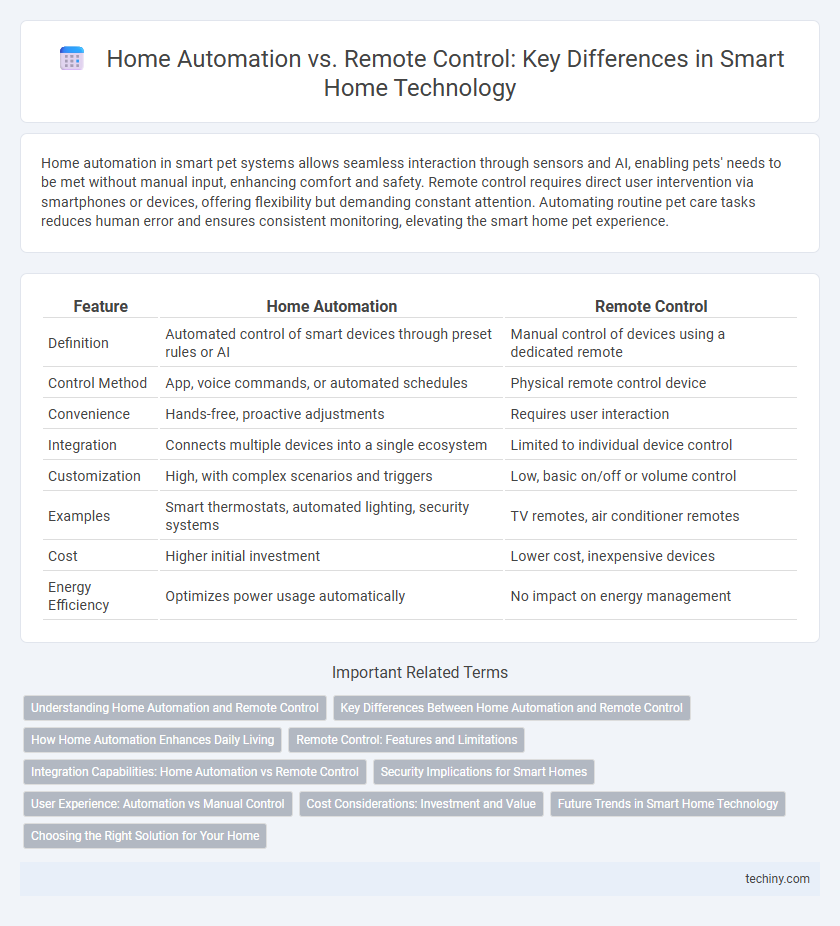Home automation in smart pet systems allows seamless interaction through sensors and AI, enabling pets' needs to be met without manual input, enhancing comfort and safety. Remote control requires direct user intervention via smartphones or devices, offering flexibility but demanding constant attention. Automating routine pet care tasks reduces human error and ensures consistent monitoring, elevating the smart home pet experience.
Table of Comparison
| Feature | Home Automation | Remote Control |
|---|---|---|
| Definition | Automated control of smart devices through preset rules or AI | Manual control of devices using a dedicated remote |
| Control Method | App, voice commands, or automated schedules | Physical remote control device |
| Convenience | Hands-free, proactive adjustments | Requires user interaction |
| Integration | Connects multiple devices into a single ecosystem | Limited to individual device control |
| Customization | High, with complex scenarios and triggers | Low, basic on/off or volume control |
| Examples | Smart thermostats, automated lighting, security systems | TV remotes, air conditioner remotes |
| Cost | Higher initial investment | Lower cost, inexpensive devices |
| Energy Efficiency | Optimizes power usage automatically | No impact on energy management |
Understanding Home Automation and Remote Control
Home automation integrates multiple smart devices into a unified system that autonomously manages lighting, climate, security, and entertainment based on user preferences and environmental data. Remote control refers to manually operating specific devices via smartphones, tablets, or dedicated remotes without centralized coordination or intelligent behavior. Understanding these distinctions helps homeowners optimize convenience, energy efficiency, and security through either automated routines or direct device management.
Key Differences Between Home Automation and Remote Control
Home automation integrates various devices and systems into a centralized platform, enabling autonomous operation based on user preferences, schedules, and sensor inputs, while remote control offers manual, direct control over individual devices from a distance. Unlike remote control, which requires active user input for each action, home automation provides intelligent, automated responses that enhance convenience, energy efficiency, and security. Key differences include scalability, with home automation systems supporting complex inter-device communication, whereas remote control typically manages discrete appliance operations independently.
How Home Automation Enhances Daily Living
Home automation integrates connected devices and sensors to create a seamless living environment, enabling automated climate control, lighting, and security based on user habits and preferences. Unlike basic remote control systems that require manual operation, home automation adapts in real time, enhancing energy efficiency and providing personalized comfort. Smart home frameworks use AI and machine learning to anticipate needs, reducing daily tasks and improving overall convenience and safety.
Remote Control: Features and Limitations
Remote control systems in smart homes provide users with convenient, direct access to appliances and devices via handheld or mobile interfaces, enabling real-time adjustments to lighting, temperature, and entertainment systems. These systems often feature infrared or Bluetooth connectivity, offering simple setup and immediate command execution without relying on internet access. Limitations include restricted range, potential interference, and lack of integration with broader home automation platforms, which limits scalability and advanced scheduling or sensor-based automation capabilities.
Integration Capabilities: Home Automation vs Remote Control
Home automation systems offer seamless integration capabilities by connecting various smart devices into a unified platform, enabling centralized control and intelligent scheduling. Unlike traditional remote control systems, which operate individual devices independently, automation solutions support interoperability through protocols like Zigbee, Z-Wave, and Wi-Fi. This integration enhances user experience by allowing coordinated actions across lighting, climate control, security, and entertainment devices.
Security Implications for Smart Homes
Home automation integrates various devices into a centralized system, enabling proactive monitoring and automated security responses that enhance protection against intrusions. Remote control, relying on manual user commands via smartphones or other devices, can introduce security risks such as unauthorized access if authentication protocols are weak. Implementing robust encryption, multi-factor authentication, and continuous security updates is crucial to safeguarding smart home systems from cyber threats and ensuring reliable operation.
User Experience: Automation vs Manual Control
Home automation enhances user experience by enabling seamless, hands-free operation of devices through intelligent scheduling and sensor integration, reducing the need for manual input. Remote control offers direct, on-demand access to smart devices but requires continuous user interaction, which may interrupt daily routines. Automation creates a more intuitive and efficient environment by anticipating user needs, while remote control provides flexibility for immediate adjustments.
Cost Considerations: Investment and Value
Home automation systems typically require a higher initial investment due to the integration of sensors, controllers, and network infrastructure, but they offer long-term value through energy savings and enhanced convenience. Remote control devices generally have lower upfront costs but lack the advanced features and scalability found in comprehensive automation setups. Evaluating cost considerations involves balancing initial expenses against potential benefits like efficiency, security, and home value appreciation.
Future Trends in Smart Home Technology
Home automation integrates interconnected devices allowing autonomous adjustments to lighting, climate, and security based on user behavior and environmental data, surpassing traditional remote control capabilities that require manual inputs. Future trends in smart home technology emphasize AI-driven predictive analytics, voice-activated systems, and edge computing to enhance responsiveness and energy efficiency. Enhanced interoperability standards like Matter will enable seamless communication between diverse devices, driving smarter, more intuitive home environments.
Choosing the Right Solution for Your Home
Home automation systems offer seamless integration of lighting, climate control, security, and appliances through centralized platforms, enhancing convenience and energy efficiency compared to traditional remote control devices that operate individual gadgets independently. Selecting the right solution depends on factors such as the scale of automation desired, budget constraints, compatibility with existing devices, and the ease of use of the control interface, whether app-based or voice-activated. Investing in a smart home ecosystem with scalable features ensures long-term adaptability and maximizes the benefits of connected living environments.
Home Automation vs Remote Control Infographic

 techiny.com
techiny.com